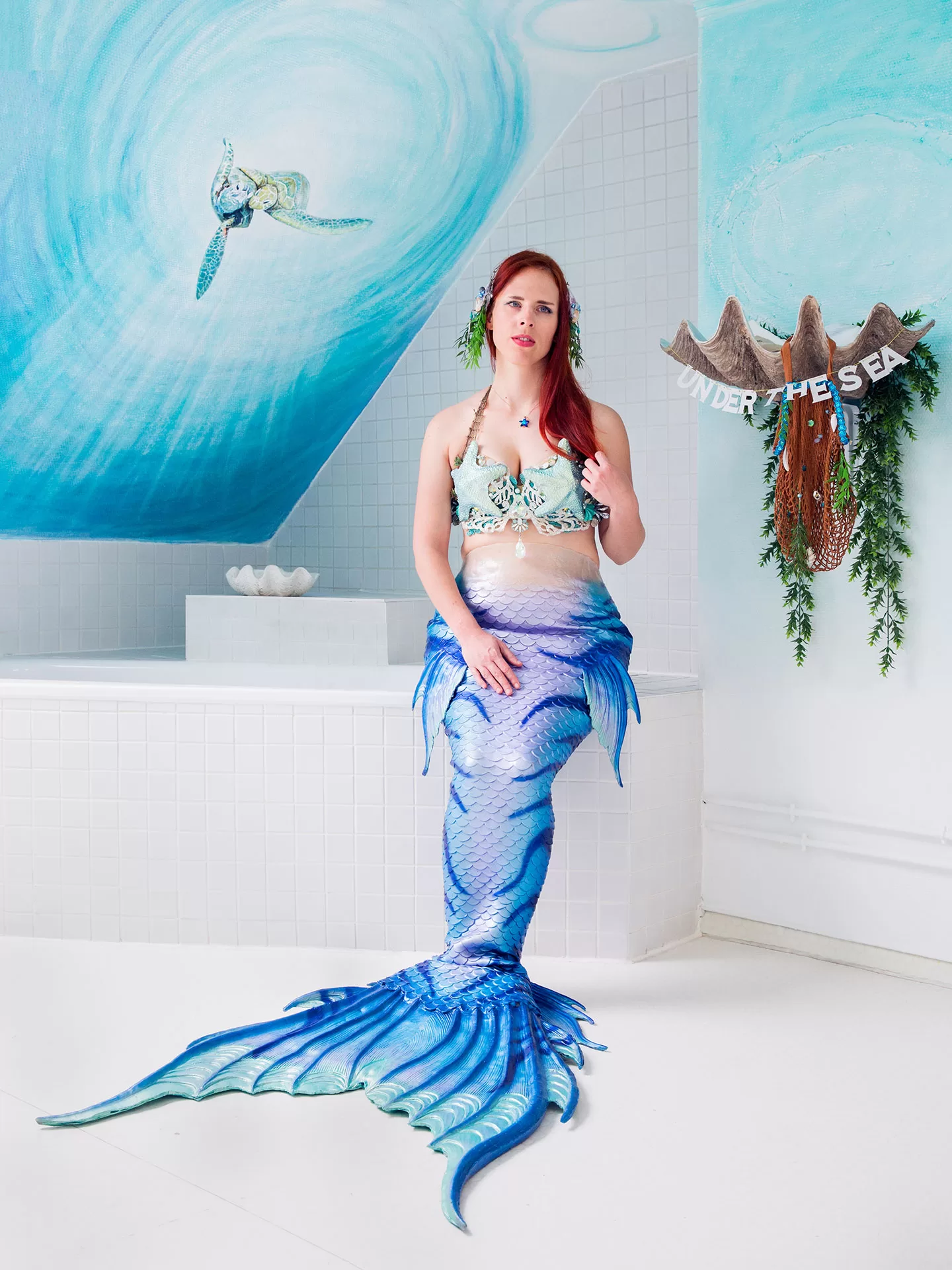The three paradigms of desire
As everything seemingly tends to become an event we desperately want to take part in, a new kind of desire arises
by Federico Leoni

Photos by Elisa Maenhout
We could isolate three paradigms of desire: Life, machinic concatenation, and impersonal events.
The three things are the three objects corresponding to the three paradigms — the desire for a living object, an inorganic thing, and an impersonal event, respectively. Three forms of the “thing” guiding our subjective movement. Three moments of a possible history of desire, one that could reconstruct the ways in which we have desired or have been called to desire by certain social, political, and economic circumstances. Perhaps even three eternal aspects of what orients our subjective movement, that coexist to some extent; sometimes in the foreground, sometimes on the fringes of the scene.

A Depth Most Would Drown In — The mermaid is one of the most iconic creatures of all time. Elisa Maenhout’s work explores the fascination for this phenomenon in this day and age and the inspiration it generates. A Depth Most Would Drown In is a documentary photography project by Elisa Maenhout that explores the fascinating world of people who identify as mermaids and mermen. These individuals embody the symbol of the mermaid, which radiates power, beauty, and self-confidence. In her images, Maenhout plays with the invisible line between reality and fiction, creating a dreamlike world that blurs the boundaries of documentary photography and staged photography. Framed between the surface and the bottom, between dream and reality, the mermaids move in a world of their own where the light behaves differently and gravity seems like an illusion. Yet, the contrast with the images taken above the water provides a necessary reminder of the reality in which we live.
The first
The first paradigm of desire is that of romantic desire, in the literary sense of the term. Here, according to the great thinker of German romanticism, Hegel, each person loves what is most alive in the other. The life of the other lights up my life. It is the living core of the other, the “thing” we wish to contact or to be contacted by. We could say there is something specular, as perhaps there always is in desire. It is my life that wants to find itself in the other, that wants to find its own vivacity in the vivacity of the other.
Or, put in other terms, it is the other’s vivacity that allows me to rediscover my own. But there is also something not completely specular, or even anti-specular, in this dynamic. It is because the other’s vitality is surprising, unpredictable, and different from my expectations that it strikes me and arouses something equally surprising, unpredictable, and irreducible to what I know of myself. When desire has something disquieting, when it questions us so much that we hesitate or run away, it is precisely because it ignites in us something we do not know, something about us that perhaps we do not want to recognize.
On the whole, a certain specularity is needed so that the anti-specular element can find its own frame, its own space of inscription; and the anti-specular element is necessary so that the anxiolytic effect of the mirror, the confirmation that specularity always brings, does not become too flat, too boring, too repetitive.
The second
The second paradigm of desire is that of machinic assemblage. Here I would recall not a philosopher but a writer, Jay McInerney. He is the author of a cult book, albeit a cult that has been largely forgotten. It is entitled The Thousand Lights of New York. Here, desire is the desire for an inorganic thing, as we could say, using a term of the Italian philosopher Mario Perniola. On the one hand, this strikes us as strange and vaguely sick.
Yet it becomes familiar as soon as we look at our everyday life with some freedom. The object of desire staged by McInerney’s novel is not at all difficult to identify. Indeed, it is right there in the title: the object of desire are the thousand lights of New York. Isn’t it something very familiar, after all, for our desires to desire the glitter of some scenery? We are faced with another paradigm, for here desire desires a situation, a concatenation of animate and inanimate beings. Most of all, perhaps, it desires the inanimate as such; it desires that which seems to live off a paradoxically inorganic life.
That which is alive because it is animated by a kind of machinic functioning. We see skyscrapers like large blocks of quartz everywhere, pulsating with a luminescence that follows rhythms in which we are included, like so many other human and non-human beings. It is the same element we find in the softness of velvet, in the texture of certain yogurts, in the perfect elasticity of our mobile phone covers, in the shimmer of certain mouths and lips that are attractive, not despite the artifice but because of the artifice.
If anything, we try to find, even in human life, the trace of life beyond humanity. We wish to be part of a chain. We desire not to get our hands on something but to invent something. We wish not to possess an object but to construct a map of possible movements. We desire to be one of the things included in this open and multiform and shared concatenation. We desire a world.

Photos by Elisa Maenhout
The third
The third paradigm of desire is the paradigm of contemporary desire. It is the desire for the event, the desire not to conquer something, not to be within a concatenation, but to precipitate into the whirlpool of an event. Today everything tends to become an event. Today, all forms of knowledge tend to define an event or a movement that was described a generation or two ago as an object or a situation. Desire is no different. It has put itself in the school of contemporary physics or philosophy.
For example, desire no longer wishes to contemplate a van Gogh painting or Banksy graffiti but to sink into the van Gogh painting, to swim in the Banksy graffiti. Desire does not desire something but desires the environment of that something; it desires to be translated into a space that includes and dissolves the observer in its almost liquid matter.
The object becomes an aquarium in which to swim or float, feeling on the skin the contact of the movement of which we are finally part, feeling in the muscles that mobile consistency no longer offered to the organs of sense alone, but to those of movement as well. That thing has finally and integrally become mine because I myself belong, fully, to that thing. There is such an unbridled desire to possess, in this way of inhabiting desire, that dispossession becomes the only way to realize it.
There is no longer the thing to take possession of, and there is no longer the subject to whom in the old world we would have ascribed that possession. The object of desire no longer stands before us. It passes through us everywhere, and at every instant; it reduces us to a more or less momentary appendage of it; it summons us according to its needs and dismisses us according to its intermittencies. It is a point that mystics have always known. Just read Teresa of Avila or John of the Cross.
The desire of the mystics has never been oriented towards an object and has never been lived from the point of view of a subject. But, interestingly, it is a technology that realizes the ghost of the mystic. All contemporary immersive technologies, which is to say all modern technologies, produce this amniotic experience of the union with the absolute, and make it available to anyone and technically reproducible ad infinitum.
It is at the most advanced point of this path that we discover that we ourselves are made of the same stuff, that we ourselves are impersonal events, that we ourselves host in the liquid consistency of our matter in, infinite, incompressible universes.





